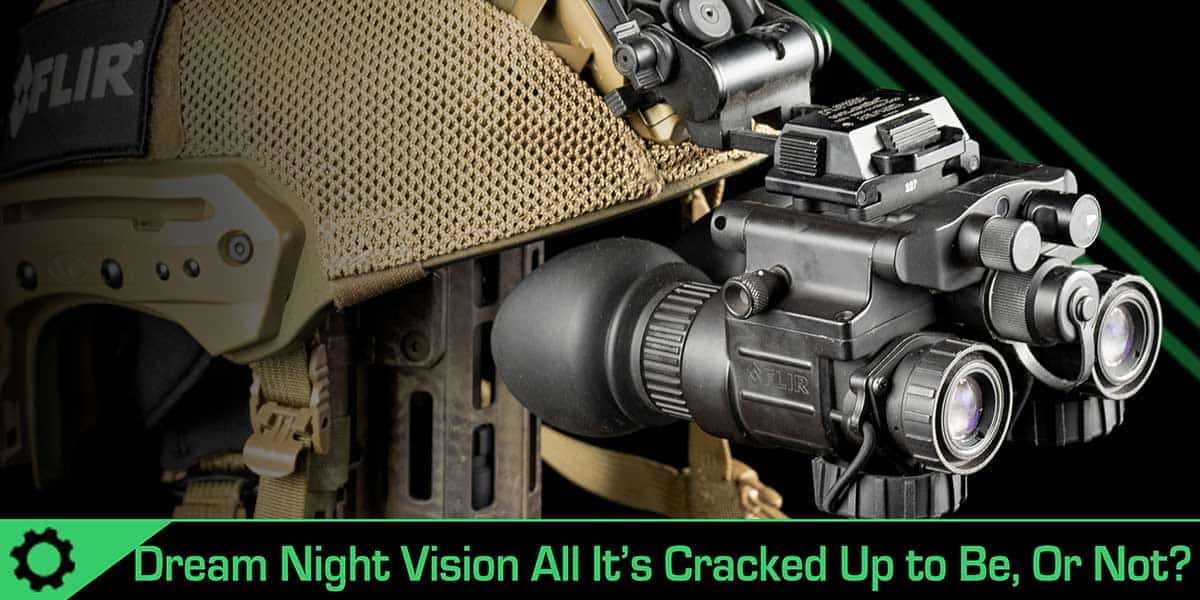 The 8 year old version of me had a Lamborghini poster on my wall. If my wife would let me put up posters as a grownup, I would have a poster of BNVDs hanging on the wall. The chance to review a FLIR FLIR BNVD-51ss 3G White Phosphor Binocular Night Vision Device, left me floored.
The 8 year old version of me had a Lamborghini poster on my wall. If my wife would let me put up posters as a grownup, I would have a poster of BNVDs hanging on the wall. The chance to review a FLIR FLIR BNVD-51ss 3G White Phosphor Binocular Night Vision Device, left me floored.
Bear in mind, I have access to a lot of night vision devices, but dual tube night vision (also call binocular night vision) had, up to this point, eluded me. It was the piece of kit I believed to be missing from my nighttime hog hunting equipment.
After hanging up the phone with Jonathan, the head honcho of SHWAT™, I had to find a chair and take a deep breath. Immediately after that, I started refreshing my email in search of a tracking number. The FLIR BNVD-51ss 3G, White Phosphor BNVDs were one the way!
One problem though – Have you heard the phrase: you should never meet your heroes? That phrase was made for people like me. I’m a Type-A, detail oriented person and have an ability to pick things apart pretty quick. So this story won’t just contain my review of FLIR’s offering, it will also give you insight into whether or not my “hero” lived up to my expectations.
At the time of this review I have a little more than 20 hours logged on the FLIR BNVD-51s under a multitude of conditions. That’s more than enough time to form a solid opinion of the optics without the “honeymoon” period clouding my judgment.
BNVD Ease of Use
The FLIR BNVD-51s are very easy to use. You have two knobs in between the monoculars that control your ON/OFF and the gain intensity. The knobs protrude far enough to make it easy to find in the dark.
The ON/OFF knob has an ON and an IR setting. The built in IR works great inside of structures, but out in the open you will need something with more throw.
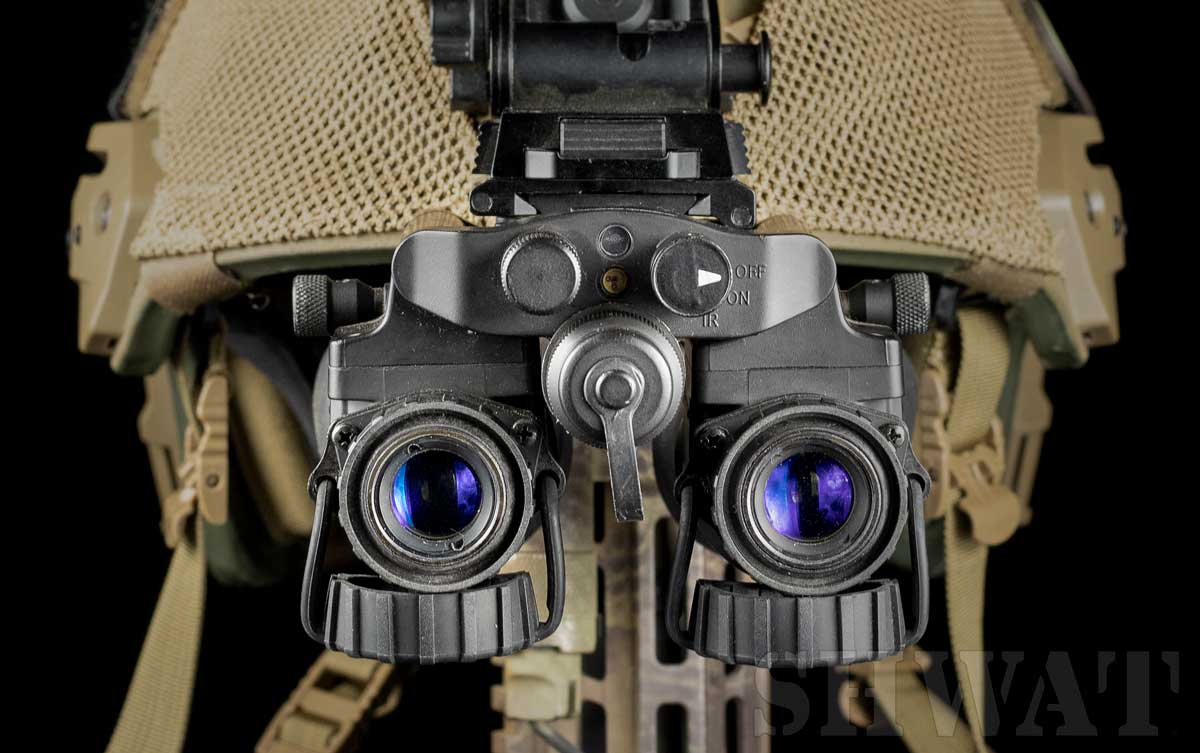
Knobs on the bridge are easy to access easy to use. And yeah, they’re dirty. You would be too if I dragged your around West Texas hunting.
The gain knob works like an oven dial, just turn to your preferred gain ‘temperature.’ I much prefer manual gain control over an auto gain. Night vision devices with auto gain are often too bright for my liking and give me a headache faster than they would have otherwise.
The FLIR BNVDs have their own built in bridge and when they are in their flared out position the tubes turn off. This feature works individually as well, so if you have the monocular on the left in the down position it would be on, and if the right monocular was in the up position it would be off. This feature combined with the Team Wendy helmet and Wilcox mount made for a versatile setup without additional configuration or parts needed on my end.
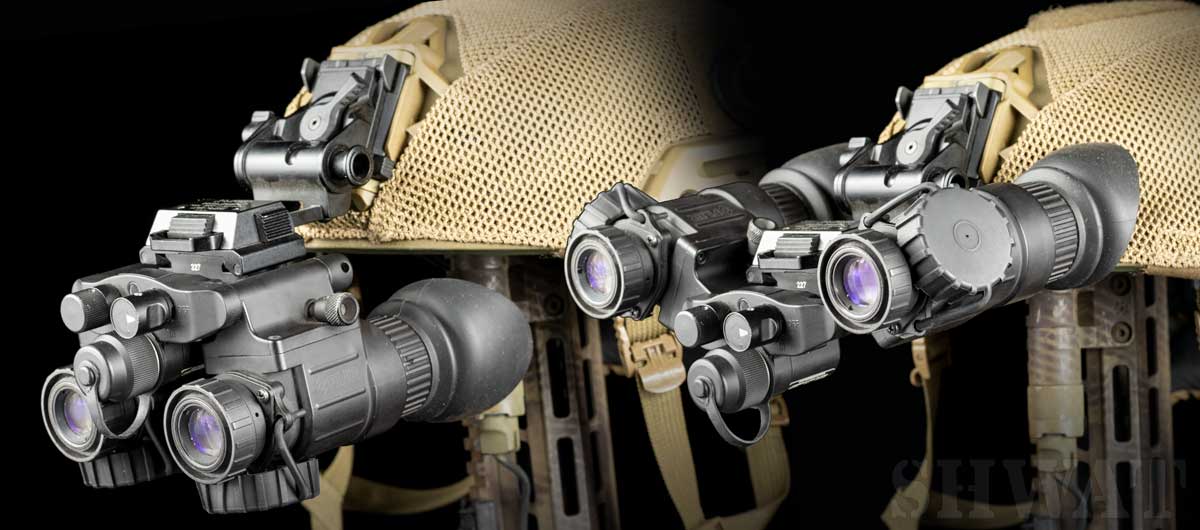 FLIR BNVD Image Quality
FLIR BNVD Image Quality
The image quality is outstanding. Both tubes have a front focus ring and rear diopter, as you would expect. After a bit of configuring, I was able to get them dialed into my liking. With night vision devices you always have to look for blemishes in the tubes that depredate the image you see. They were pretty non-existent on my pair of BNVDs. You really have to look hard to find any.
FLIR has 4 BNVD models, the 3A, 3F, 3G, and 3AG. These are the 3G version of the FLIR BNVD-51s. The G in 3G stands for Ghost, aka, “white phosphor.” The white phosphor did not disappoint.
It doesn’t allow you to actually see better, but it makes the image less harsh and more natural to process, in my experience. With traditional night vision, I get eye strain much quicker than I did under this FLIR unit.
What really sets these apart though, is the “51” in BNVD-51s. The 51 stands for a 51 degree field of view. Most tubes have a 40 degree field of view. The 11 extra degrees give you roughly a 28 percent increase in your Field Of View (FOV). That’s quite noticeable!
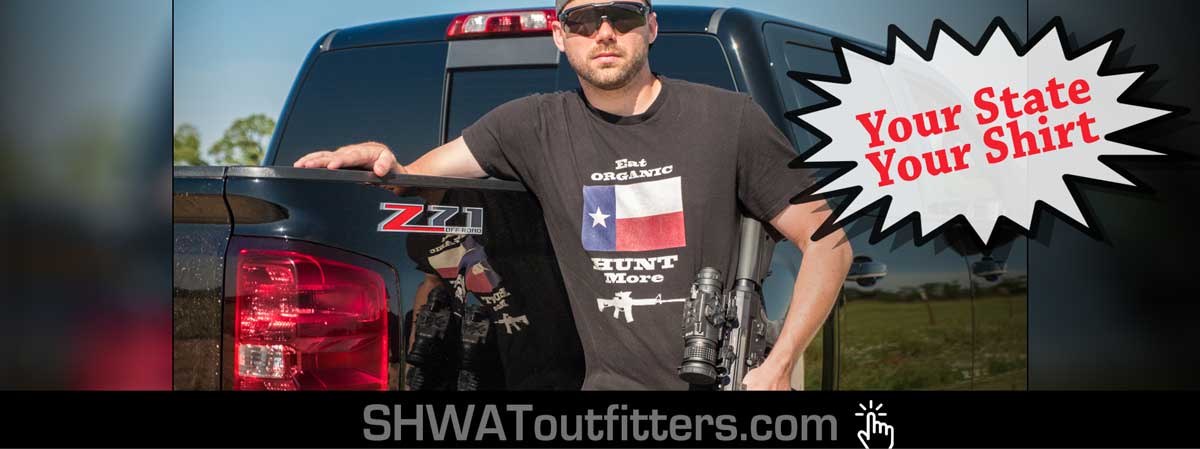
Yep, that’s me. Rocking my Texas shirt. Get one from your state. Now is a good time. Seriously.
Often in the world of high-end optics, FOV is touted as a major selling point, and for good reason. But in regards to night vision devices, I would say it’s even more important. Why? All night vision gives you tunnel vision, so the “wider” you can make that tunnel, the more aware you will be of what is going on around you. So, I give FLIR two thumbs up on that.
Powering the BNVDs
The FLIR unit is dual fuel capable. Which means it can run off of a CR-123 or AA. On more than one hunt in the past few years we ran out of CR-123s. Try finding these Po-Dunk Texas… Let me know how that goes for you, but you will find AA batteries in every gas station in the United States.
FLIR says the battery life is about 20 hours. They sell an external battery pack that gives you up to 80 hours and will work as a counter weight. For what I do, 20 hours at a time is plenty.
Where BNVDs Made a Difference
My favorite hog hunting place is the farm. It’s roughly 2,500 acres of farm land interconnected across west Texas. The farm roads there take us on a 26 mile loop through all of the fields we are able to hunt.
We typically do 2-3 loops per night depending on how things go. Equipment can vary, but I prefer to hunt under a rifle mounted thermal optic. Our biggest enemy is often the truck’s headlights. Sometimes they spook groups of hogs, other times they don’t.
For us, “sometimes” doesn’t cut it for us. We need that number to be 0.
In the past we would drive with the lights out and no night vision. As long as you have a little bit of moon this is doable, but you have to go painstakingly slow in order to be safe. Eventually we graduated to PVS-14 night vision monoculars.
This worked much better, but there is a learning curve and working with just one eye adds to the depth perception issues. Under a single PVS-14 monocular, the max speed I feel safe going on the roads we drive is about 30 mph in good conditions.
Thus my longing for BNVDs.
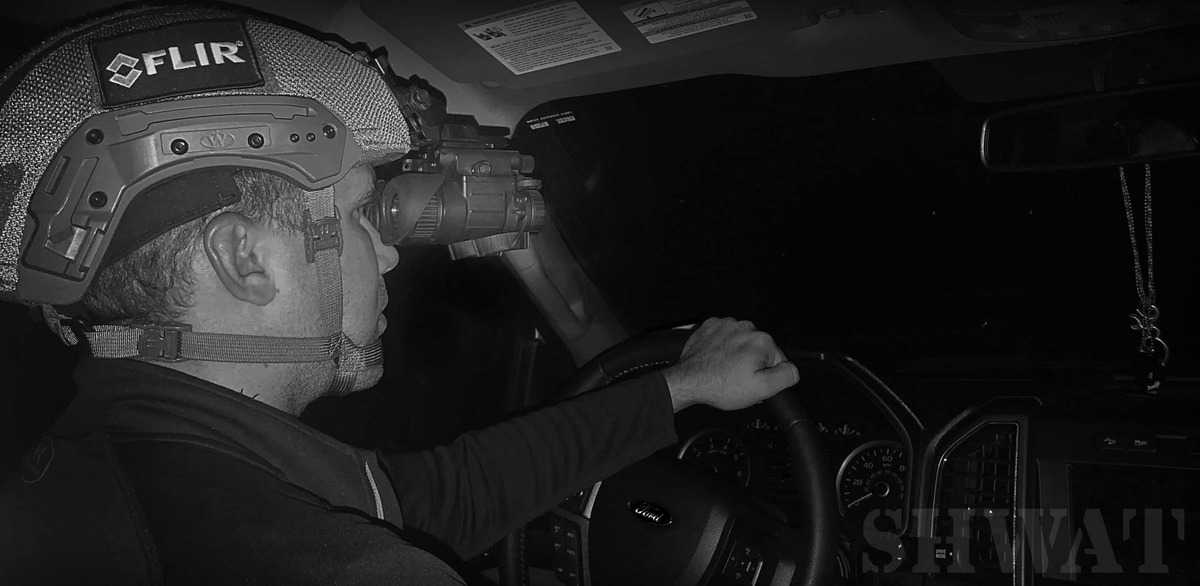
Yeah, this is what night driving should be!
I felt like Ken Block in a rally car my first night out as driver with these bad boys. Fellow Pro Staffer Jared Hilton and the Texas Gun Experience General Manager J.D. Devine were along for the ride.
I’ve never heard so much fear and whining coming out of two grown men in my life! I confidently blazed through the farm roads at 50 mph under the pitch black cover of night. They could see the speedometer but not the front of the truck, leading to great concern coming from both of them throughout the night.
Our roads are pretty well maintained, and in the daylight 50-60 mph is about as fast as you would safely go on certain sections. What the crybabies couldn’t understand is how well I could see, how good my depth perception was, and how safe we all actually were.
To me there is a huge difference in driving under dual tubes vs. a single tube. Finally, around 2:00 in the morning I slammed on the brakes and forced both of the bellyachers to peer through FLIR’s BNVD-51s. Once the peace of understanding overcame them we resumed our hunt. Sharing is caring, right?
Living Up To Expectations?
So, did the mythical dual tubes live up to my child-like expectations? Yes and no.
They are awesome and I have laid that out in this story, but they do have a few drawbacks. They are double the weight and double the bulk of a PVS-14. This means you need a heavier counterweight on your helmet to balance it out. Which of course leads to more weight on your head, so your neck wears out more quickly.
Of course, you can get used to this, but it’s hard to do unless you use them frequently, and unfortunately I don’t get to hog hunt on a weekly basis.
The bulk took some getting used to as well. I am right eye dominant and would normally run a PVS-14 over my left eye when driving and stalking. When it is time to shoot I flip it up and go to work through my thermal (typically a FLIR 536).
On my first outing with the FLIR BNVD-51s I got into position flipped them into the up position. When I pulled the trigger the recoil caused the power button on the thermal to bump the BNVDs. The thermal went down and dozens of hogs had the luckiest night of their life. Okay, maybe not dozens, but some of the dozens at least…
Lesson learned, I did not repeat that mistake. It took a few adjustments but it all worked out from that point on.
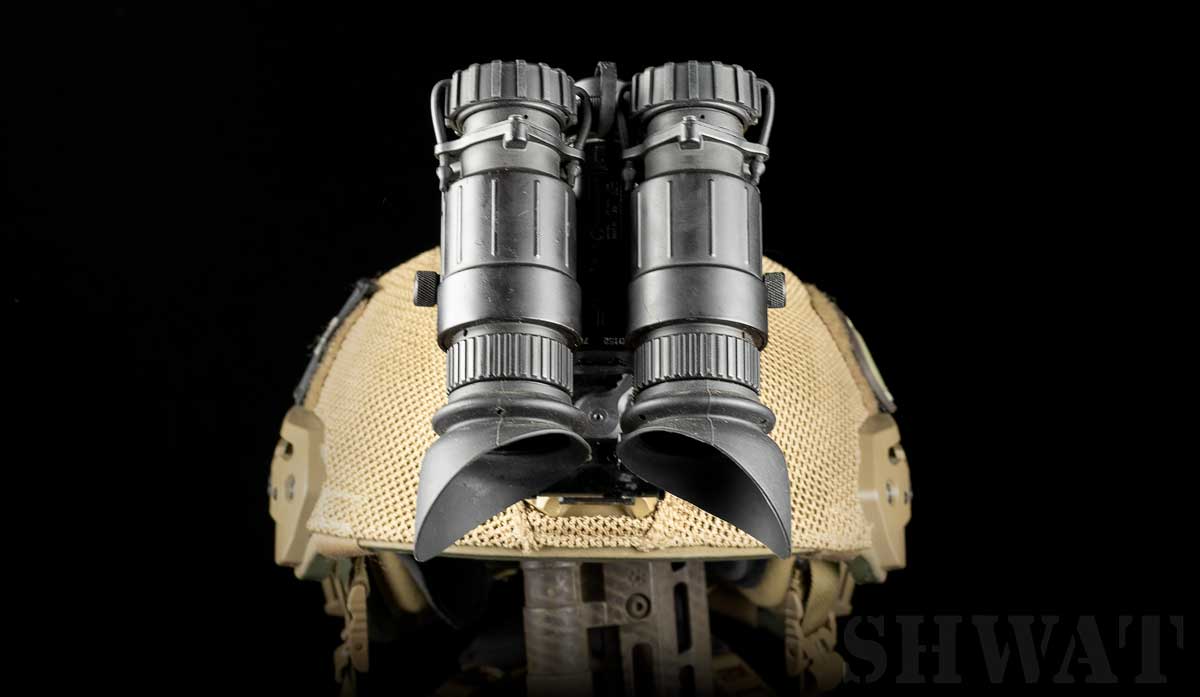 Are BNVDs as Magical as I Dreamed?
Are BNVDs as Magical as I Dreamed?
FLIR has a real winner here with the BNVD-51s. In my opinion, that 51 degree field of view really sets them apart from the competition. The big question is, was the difference between a PVS-14 and BNVDs as magical as I thought it would be?
No. It wasn’t. But can I go back to a single tube now? Also no.
It’s like keyless entry on a vehicle: you don’t necessarily need it, but once you have it, you can’t go back. And these aren’t going back either. I’ve blocked Jonathan on all social media platforms and my phone, moved to another zip code, and am now living off the grid. So, if he wants them back, he is going to have to buy a second pair and come find me. And you should too.

